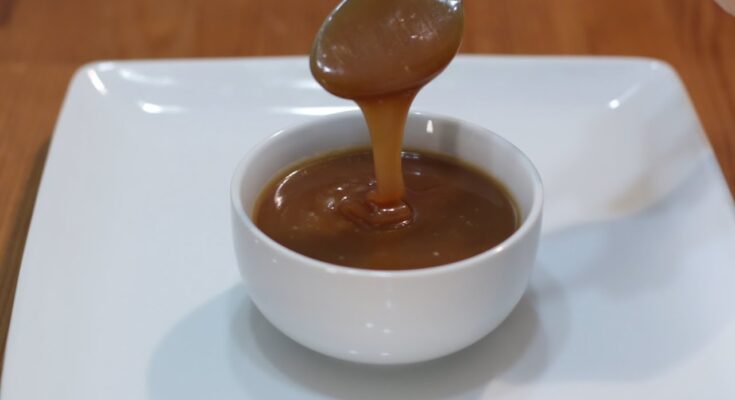Caramel Recipe: Caramel is a delightful confection made by cooking sugar until it reaches a golden brown color. This versatile treat can be used in desserts, drinks, and even savory dishes, adding a rich, buttery flavor.
Why Make Caramel at Home?
Making caramel at home not only gives you control over the ingredients but also ensures a fresher and more flavorful outcome. Store-bought caramel often contains preservatives, while homemade caramel can be tailored to your taste and dietary needs.
Types of Caramel Recipes
There are various caramel recipes, including wet caramel (made with water and sugar) and dry caramel (sugar cooked alone). Flavored variations such as salted caramel or vanilla caramel add exciting twists to the classic recipe.
Essential Ingredients for Caramel
Basic Ingredients for Simple Caramel
- Granulated sugar
- Water (optional, for wet caramel)
- Unsalted butter
- Heavy cream
- A pinch of salt
These ingredients form the foundation of most caramel recipes.
Additional Ingredients for Flavored Caramel
For a unique spin, you can add:
- Vanilla extract for a deeper flavor.
- Sea salt for salted caramel.
- Chocolate for a rich, indulgent twist.
Tools and Equipment You’ll Need
Must-Have Kitchen Tools for Caramel
- A heavy-bottomed saucepan: Ensures even heating.
- A wooden or silicone spatula: Prevents sticking and burning.
- A candy thermometer: Monitors the temperature accurately.
- Measuring cups and spoons: For precise ingredient proportions.
Tips for Choosing the Right Equipment
Opt for nonstick pans to avoid caramel sticking and burning. Use heat-resistant utensils to prevent melting or damage while stirring the caramel.
Step-by-Step Guide to Making Caramel
Preparing the Ingredients
Before starting, measure all your ingredients and keep them ready. Caramel is a time-sensitive process, and having everything at hand ensures smooth cooking.
The Dry Method vs. The Wet Method
- Dry Method: Heat sugar alone in a pan, stirring occasionally until it melts and turns golden brown.
- Wet Method: Dissolve sugar in water, then cook until it caramelizes. This method gives more control but takes longer.
Cooking the Caramel – Timing and Technique
- Place sugar (and water, for the wet method) in the saucepan.
- Heat over medium flame, stirring gently.
- Watch for the sugar to melt and turn a golden amber hue.
- Remove from heat immediately to prevent burning.
- Carefully add butter and cream, whisking continuously to create a smooth mixture.
How to Store Caramel
Storing Homemade Caramel Properly
Store caramel in an airtight container at room temperature for up to a week. For longer storage, refrigerate it in a sealed jar for up to a month.
Tips for Reheating and Reusing Caramel
Reheat caramel over low heat, stirring gently. Avoid overheating, as it may separate or burn.
Troubleshooting Common Caramel Issues
Why Does Caramel Burn?
Burning is a common mistake when making caramel. It happens when the sugar cooks too long or at too high a temperature. Always keep an eye on the caramel as it heats, and remove it from the stove as soon as it reaches the desired amber color.
Tips to Prevent Burning:
- Use medium to low heat for better control.
- Stir gently but consistently, especially in the dry method.
- Monitor the temperature with a candy thermometer, aiming for around 320°F (160°C).
Fixing Grainy Caramel
Graininess occurs when sugar crystals form during cooking. This can ruin the smooth texture of caramel.
How to Avoid Grainy Caramel:
- Use clean utensils and avoid introducing water droplets into the mixture.
- For the wet method, brush down the sides of the pan with a damp pastry brush to dissolve sugar crystals.
- Stir less frequently once the sugar dissolves.
What to Do if Caramel Crystallizes
If your caramel crystallizes, it may look clumpy or gritty. To salvage it:
- Add a splash of water and gently reheat the mixture over low heat.
- Stir carefully to dissolve the crystals without incorporating air.
Delicious Caramel Variations to Try
Salted Caramel
Salted caramel has become a favorite for its balance of sweetness and saltiness. To make it, simply add a generous pinch of sea salt or flaky salt to your finished caramel sauce. It’s perfect for drizzling over desserts or pairing with chocolate.
Vanilla Caramel
Vanilla caramel adds a layer of warmth and depth to the traditional recipe. After removing the caramel from the heat, stir in 1–2 teaspoons of vanilla extract. It works beautifully in coffee or as a topping for ice cream.
Chocolate Caramel
For a decadent twist, melt a handful of dark or milk chocolate into your caramel once it’s off the heat. Stir until smooth, and use it as a filling for candies or a dip for fruits.
Creative Ways to Use Caramel
Caramel Desserts
- Drizzle Over Ice Cream: A classic way to enhance vanilla or chocolate scoops.
- Layer in Cakes and Cupcakes: Add a rich, gooey center to baked goods.
- Make Caramel Popcorn: Perfect for movie nights or parties.
Savory Dishes with Caramel
Caramel isn’t just for desserts! Use it to glaze meats like pork or chicken, or drizzle it over roasted vegetables like carrots for a sweet-savory combo.
Caramel Beverages
- Stir into coffee for a homemade caramel latte.
- Mix into hot chocolate for a luxurious twist.
- Create a caramel syrup to sweeten teas or cocktails.
FAQs about Caramel Recipe
1. What ingredients do I need for a basic caramel recipe?
To make classic caramel, you need sugar, water, heavy cream, butter, and a pinch of salt. Some recipes might also include vanilla extract for added flavor.
2. How do I prevent my caramel from crystallizing?
To prevent crystallization, avoid stirring the sugar and water mixture once it starts boiling. Brushing the sides of the pan with a wet pastry brush can help dissolve any sugar crystals that form.
3. What’s the perfect temperature for caramel?
Caramel reaches its ideal consistency and flavor when cooked to the firm-ball stage, which is between 245°F to 250°F (118°C to 121°C). Using a candy thermometer can help you monitor this accurately.
4. Can I make caramel without a candy thermometer?
Yes, though it’s less precise. A common test is the cold water method, where a drop of caramel syrup is added to cold water. It should form a firm but pliable ball when it’s ready.
5. How do I fix caramel that’s too hard or too soft?
If your caramel is too hard, reheat it slowly while adding a bit of cream. If it’s too soft, cook it a bit longer to reduce the moisture content.
6. How long can I store homemade caramel?
Homemade caramel can be stored in an airtight container in the refrigerator for up to two weeks. Make sure it’s wrapped well to keep out moisture and other flavors.
7. Can caramel be frozen?
Yes, caramel can be frozen for up to three months. Wrap it tightly in plastic wrap and then seal it in a zipper-lock bag to prevent freezer burn.
Conclusion and Final Tips
Making caramel at home is an exciting and rewarding experience that allows you to customize flavors and textures. While the process requires attention and patience, the result is a rich, versatile ingredient that elevates any dish. Remember to practice safety while cooking, as caramel can reach very high temperatures. Whether you’re making a simple sauce or a flavored variation, your homemade caramel will surely impress.



